Keyword popularity fluctuates throughout the year, but keyword research tools are able to give you the average number of monthly searches for specific keywords globally or in particular locations.
Importance of Search Volume Metric in Keyword Research
Simply put, the higher the search volume, the greater the traffic potential. In order to make your SEO strategy effective and lucrative in terms of both traffic and conversion, you need to consider the search volume and business potential of the keywords you’re targeting.
In essence, find keywords that:
- Have actual search demand
- Relevant to your target customer
The key is to find the keywords that your target audience is actively looking for. They could be transactional keywords (that indicate their readiness to purchase) or informational keywords (that reflect their pain points, interests, and concerns). Once you find these keywords, strive to target those with good search volume. To do that, you would need to use a reliable and accurate keyword volume checker to zero in on those keywords that can maximize your content’s reach.
6 Best Keyword Volume Checkers
The following are some of the best keyword volume checkers that can help you identify popular search terms and predict how much organic traffic you can potentially acquire.
1. Google Keyword Planner
Since it’s Google’s property, Google Keyword Planner should be at the top of this list in terms of search volume accuracy. It pulls data directly from the Google search engine and does so in real-time.
Google Keyword Planner is free to use. However, if you want to access exact search volumes, you have to run Google ads via Google AdWords. As shown below, without an active campaign running, you’d only see the range of average monthly searches which is quite too broad to depict a specific estimate.
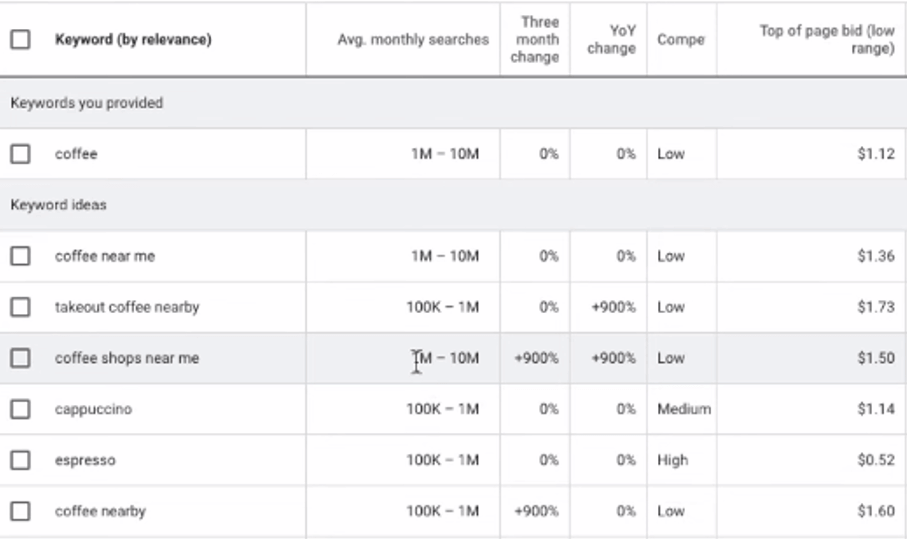
Using our Keywords Everywhere extension, you can see the search volume data on Google Keyword Planner even if you’re not actively running ads on Google. On top of the search volume, you’d also see the CPC, competition score, and Trends chart for each keyword.
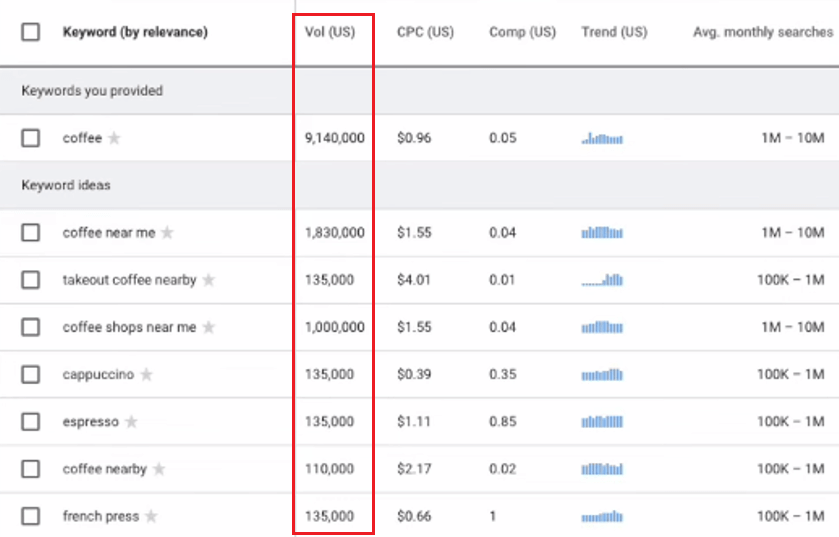
2. Keywords Everywhere
Keywords Everywhere has a plethora of other robust functionalities for keyword research and SEO. Our keyword generator tool pulls data from Google Keyword Planner, so it’s just as accurate. But being a browser extension, you can check the keyword search volume with more convenience and advanced functionality. Keywords Everywhere displays the search volume and other keyword-level data as you Browse Google, YouTube, Bing and many other major platforms.
As you navigate Google search, you’ll see the search volume immediately without having to log in to a search volume checker and type in a query.

If you check Google auto-suggest, we will automatically show the search volume and keyword metrics of the suggested queries as well:
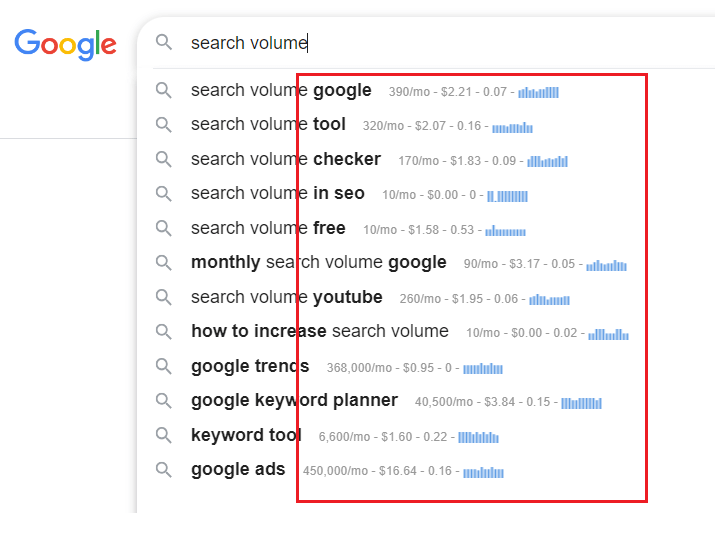
If you look over to the right, you’ll see more keyword insights from SEO difficulty to Trends data to more keyword ideas along with their corresponding search volumes:
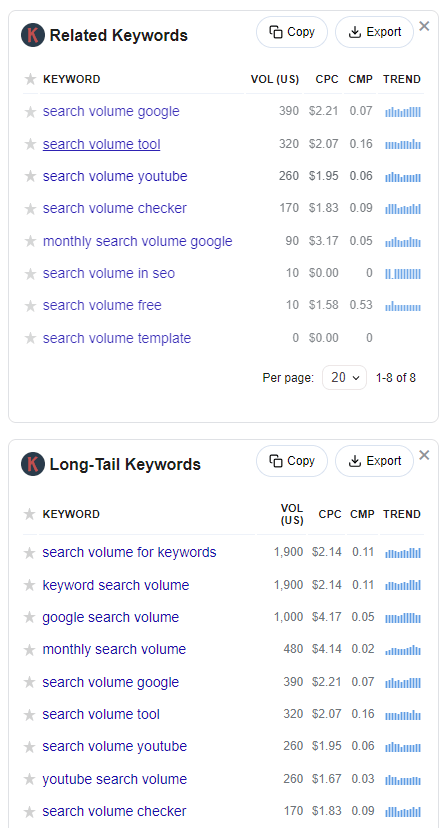
Using a browser extension as a keyword research tool allows you to validate keyword ideas as you go and avoid constantly switching between tabs as you perform keyword research and content optimization. If keyword research has become your way of life, this level of functionality can be a game-changer.
3. Semrush
Semrush makes use of clickstream data from multiple sources and allows you to instantly generate keyword ideas capturing both broad, high-volume search terms and niche, long-tail keywords.
Semrush updates their search volume data every month and uses machine learning algorithms to get the search volumes of billions of keywords. To use Semrush as a keyword volume checker, just go to Keyword Overview and input the target keyword you want to check or expand. You can also set the country to get search volume data on a national level, and you’ll also see the Global Volume as well as the breakdown of the top countries where the keyword is in demand.
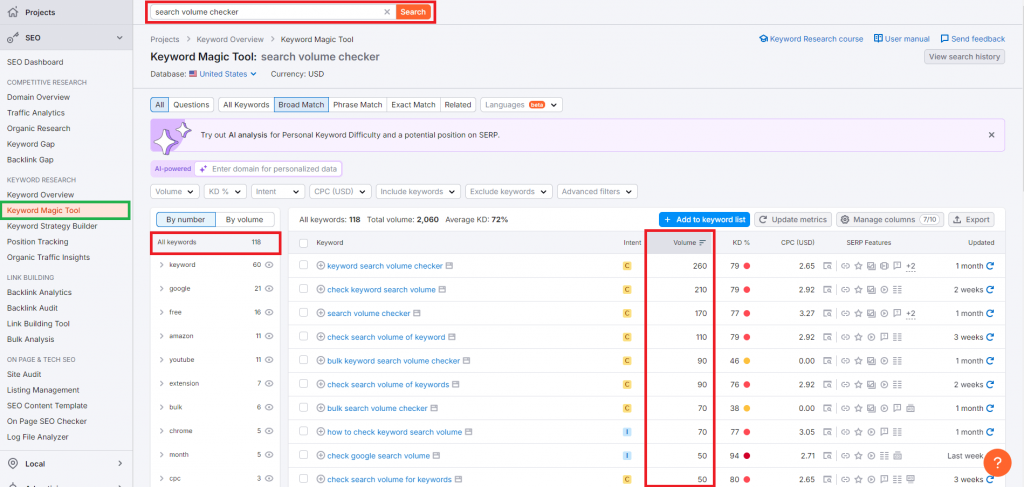
If you click Keyword Magic Tool, you’ll get the full list of other related keyword ideas, so you can decide which variant has the best search volume and keyword difficulty and also gather LSI keywords to further optimize your content. Semrush pricing starts at $139 per month.

4. Ahrefs
Ahrefs makes use of Google Keyword Planner, Google Trends data, and other third-party data sources to estimate keywords’ search volumes. They have launched a free tool Ahrefs Free Keyword Generator where you can input a keyword and instantly generate related keyword ideas along with their search volume and difficulty. However, the free tool only shows thresholds instead of exact value:
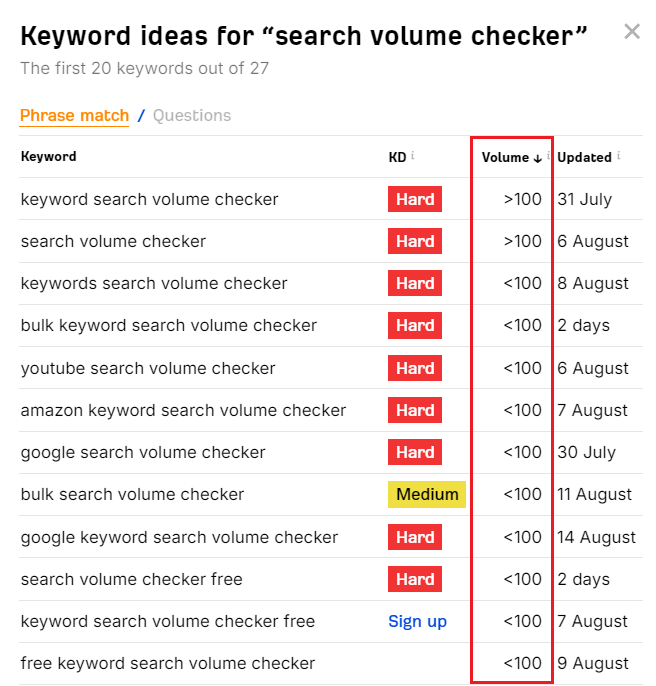
If you want to get the exact value of the search volume, you need to subscribe to one of Ahref’s plans which start at $129 per month. Subscribing to Ahrefs gives you access to a host of other keyword research tools and features including Site Explorer, advanced backlink analysis tools, Rank Tracker, site audit, and more. As a search volume checker, the paid plan also gives you access to more advanced features like search volume forecasting as highlighted below:
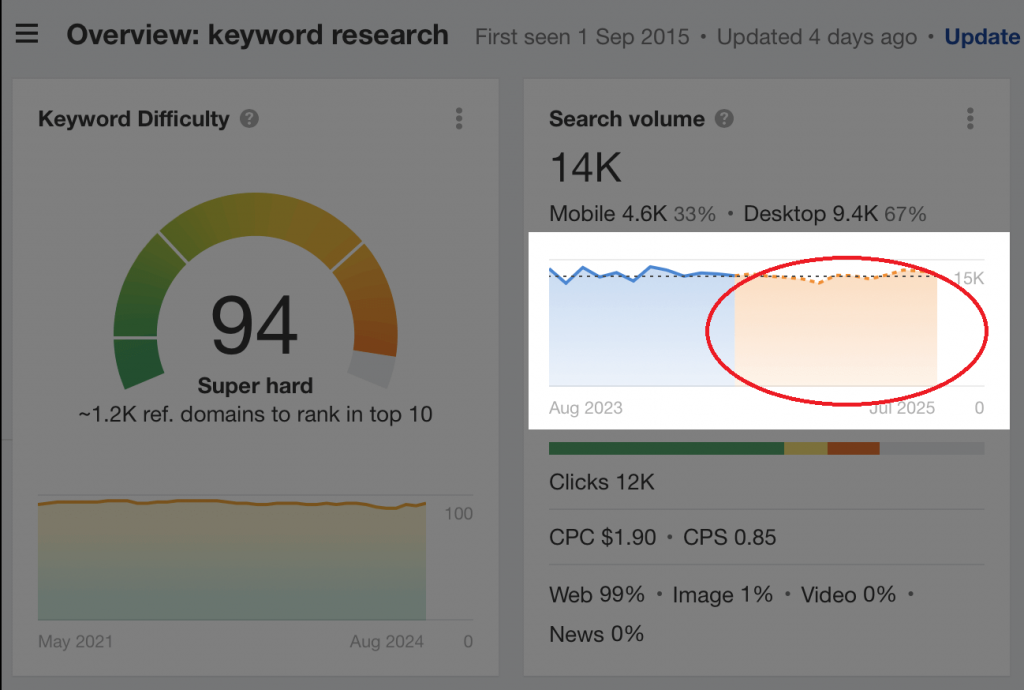
Like any other forecast, it’s not 100% accurate, but it does help you anticipate possible future trends and refine your keyword research strategy.
5. SearchVolume.io
Searchvolume.io is another free keyword research tool that allows you to check the search volume of a list of keywords in bulk. You can input up to 800 keywords at a time. If you want to generate keyword ideas and check the search volume for free, you can use searchvolume.io in tandem with free Google Keyword Planner and other free tools like Ahrefs Free Keyword Generator. You can come up with a list of ideas and then run them through searchvolume.io to get their search volume metrics in one go.
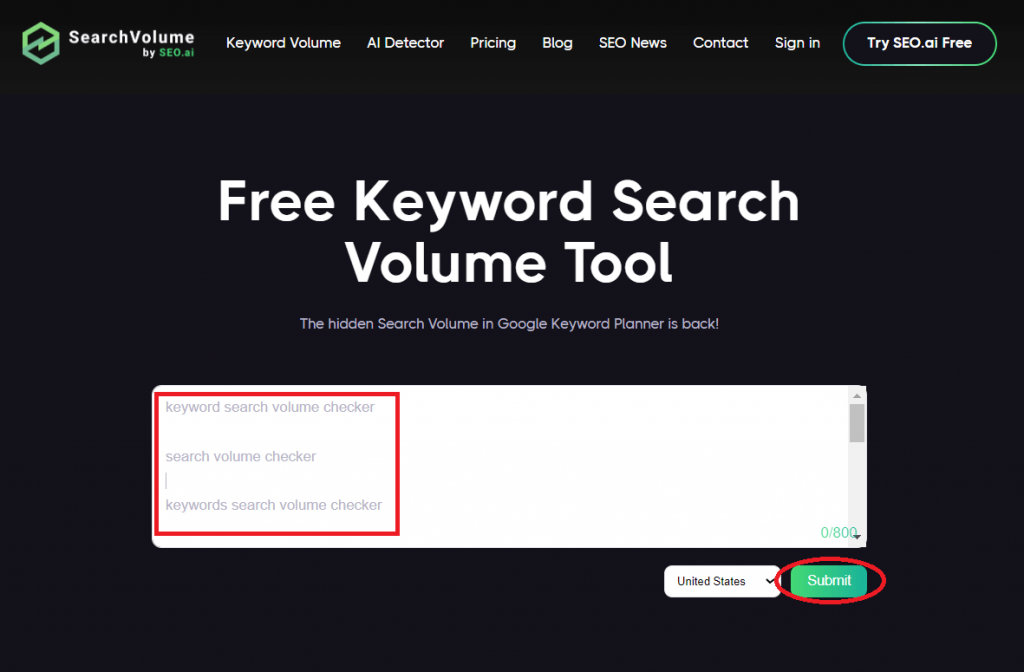
Just input the list of keywords you want to check and the search volume data will appear in seconds. You can also download a CSV file for further analysis or future use.
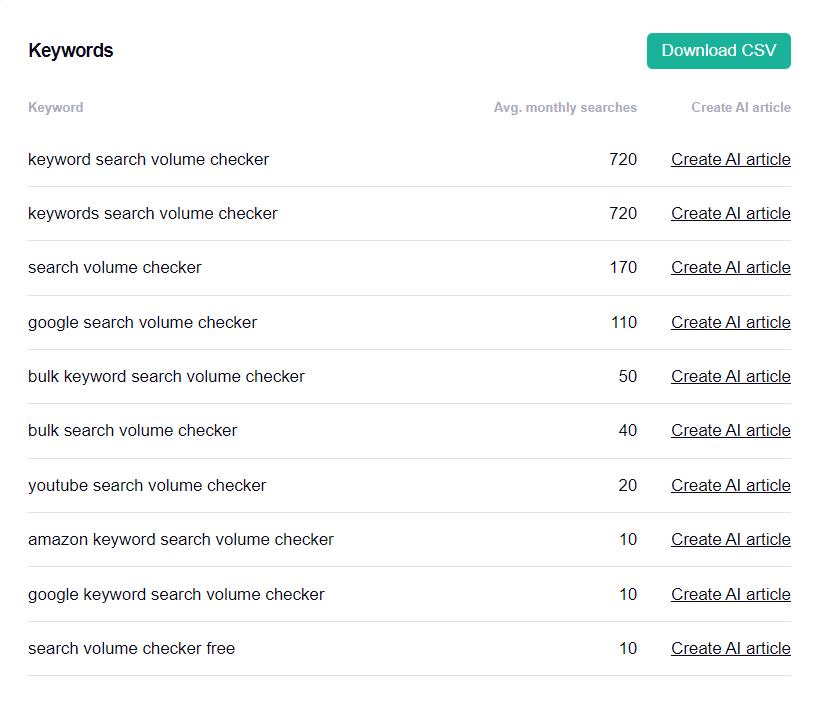
6. WordStream’s Free Keyword Tool
WordStream is now WordStream by LocaliQ, offering comprehensive digital marketing services to companies across industries. They have a collection of free digital marketing tools you can use including Wordstream’s Free Keyword Tool, perfect for the basic functions of generating more keyword ideas and checking their search volumes. You can also check the CPC for low and high-range page bids as well as the competitive density of each keyword.
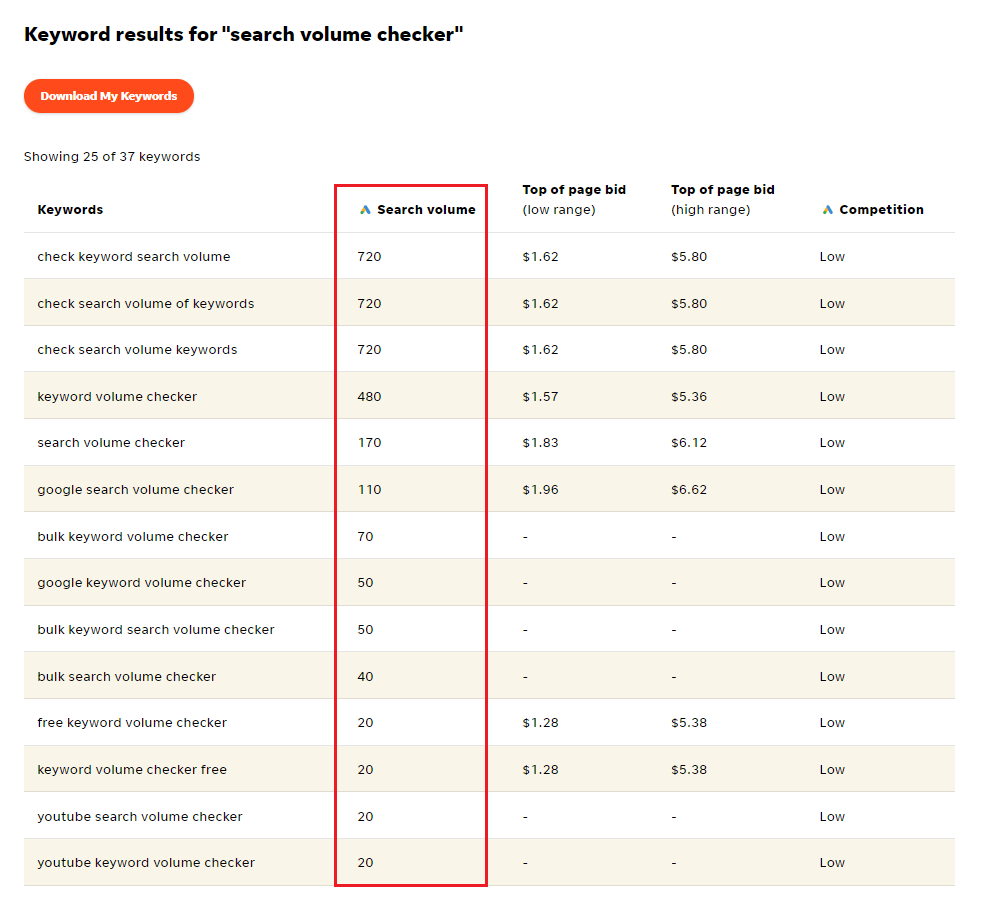
The tools above are just some of the reliable search volume checkers you can use to validate and expand your keyword ideas. However, although search volume is, no doubt, a valuable metric in keyword research, marketers shouldn’t take them at face value and strive to get more granular with the data– from search volume to search intent to business potential.
What is a Good Search Volume for a Keyword?
The exact number depends on whether you’re operating a new website or an established brand. For a big company, a keyword with 500 searches per month may be deemed low, but for a smaller, more niche brand, that number could already be ‘good’ enough.
There’s no definitive answer in terms of the exact search volume you should be targeting, but a keyword with 100-1000 searches per month would already generate decent levels of traffic– especially if you target multiple keywords per week or per month. All your SEO efforts will add up, and before you know it, your organic traffic will show steady growth and drive more business your way.
Tips for Targeting Low Search Volume Keywords
Keywords with lower search volume are generally more specific and less competitive and thus could be easier to rank for. Plus, because these are usually long-tail keywords with very specific search intent, the conversion rates could also be higher. If you are yet to establish your website’s authority, it helps to hone in on the low-hanging fruits that can generate results with minimal effort. Covering topics that are more specific could also show your topical authority, and since the keyword difficulty is much lower, you don’t have to worry a lot about competitors getting in the way.
Here are some tips for targeting low search volume keywords:
1. Don’t be afraid of zero volume keywords
The thing is, not all zero-volume keywords actually have zero searches. Some SEOs even gear their SEO strategy towards zero volume keywords. Zero volume keywords are also called ‘golden ratio keywords’, ‘hidden keywords’ or ‘zero competition keywords’. Their traffic is often under-reported by keyword research tools, and they’re generally the search terms that Google doesn’t seem to care about YET.
However, that doesn’t mean that those low-search volume keywords will never pick up. Google receives over 500 million searches every day, and around 15% of these queries have never been seen before. Plus, you don’t have to target just one specific keyword. You can use as many semantically related keywords as you can on one page to try to rank for multiple similar keywords in one go. Take note that Google is able to recognize when a zero-volume keyword carries the same meaning as other more popular keyword equivalents. Just focus on creating content that people actually need and enjoy, and you’ll eventually build up more organic traffic one post at a time.
2. Focus on value
Speaking of value, never target keywords just because they’re easy. The goal is to genuinely help your audience, no matter how small the search demand is. Sure you can try to be more strategic with your content marketing budget and spend more time, energy, and money in winning the more competitive search terms, but you shouldn’t leave low-search volume keywords to chance either.
Satisfy the search query as best as you can, and do the same process over and over again until you have thoroughly answered loads of queries and naturally established your topical authority and expertise in the field. That alone would eventually make Google notice how awesome and deserving you are of some free traffic and more visibility.
3. Answer real pain points
Even if the query has zero search volume, but you have repeatedly heard the same question from your customers or stakeholders, that could be a real pain point and content gap. Sometimes, you’ve got to trust your gut. A good topic is a good topic if it has actual search demand, even if the search volume checkers have yet to report their actual value.
If your strategy involves targeting multiple keywords with little to no search volume, you’re on your way to tapping areas that some SEOs could miss. Plus, you’re helping Google fill potential content gaps and ensure that all searchers end up finding what they’re looking for.
Tips for Targeting High Search Volume Keywords
If your site is still new, does that mean you can’t target high-volume keywords? What is the best approach when it comes to covering competitive search queries? Here are some important things to consider:
● Manage expectations in terms of click-through rates
Take note that high search volume does not always mean high search traffic. Paid ads usually target popular search terms, so even if you rank for high search volume keywords, since many paid ads are taking up space in the SERPs, you could still end up getting little to no clicks. Also, searchers may no longer bother clicking your page if Google’s featured snippet and AI Overviews are enough to get the answer they need. The thing is, it’s a good idea to target some competitive keywords, but just don’t expect a ton of clicks as there could be a lot of other variables involved.
● Map the landscape
This involves more attention to detail– actually checking the pages ranking high up and identifying the potential reasons why they’re doing so well. As you do this audit, you can find common grounds that you can build on, outline your content better, and produce more valuable and thorough content that Google and readers will adore. From writing style to scannability to visuals and videos, map the landscape and aim to deliver nothing but the best.
● Optimize for voice search
People nowadays love speed and convenience more than ever, thus the rising popularity of features like voice search. In fact, over 50% of adults worldwide use voice search every day, and the trend is only bound to increase. The key to optimizing your post for voice search is to aim for Position Zero on Google, aka the Featured Snippet.
Voice assistants often pull responses from featured snippets to answer general voice searches. To win a Featured Snippet, format your content in a concise and clear manner. Use headers to highlight key information and aim for a direct answer to a question (around 50-60 characters). This is one of the fastest ways to steal traffic from bigger sites while establishing topical authority in the process.
● Ensure proper keyword placement
Keyword placement still matters, but the key is to ensure ‘proper’ keyword integration. Gone are the days when spamming and stuffing keywords would suffice to outrank in the SERPs. Google has come a long way since those olden days. In fact, unthinkingly peppering and flooding your content with keywords is now the fastest way to get flagged.
Google continues to further refine its algorithms to make sure that only the most relevant results make the cut. Since Google is constantly moving the goalpost, the best approach is to focus on creating value while intelligently using semantic terms to optimize your page. You can use keywords in these places:
- On top of your article to assure your audience and Google crawlers that they’re reading the right content
- In Title Tag, Meta Description, and the body of your article.
- Ideally on the URL as well
- Synonyms of keywords on the subheadings.
Focus on using keywords as naturally as possible and don’t insert them for the sake of reaching a specific density. In fact, keyword density is no longer thought to be a significant ranking factor nowadays. Instead, to add more heft to your keywords, you can do more internal linking and work towards making your overall content as helpful as possible.
● Focus on creating rockstar content!
It can’t be stressed enough: there’s no substitute for compelling content. Period. It’s better if instead of gaming the system, SEOs just focus on helping Google do its job better– giving people exactly what they need in a concise and engaging way. Creating content shouldn’t just be seen as a way to increase DA score or quantify SEO success. It actually has a more important role: giving you a chance to build a relationship with your target audience and show what you can do and offer.
Conclusion
Keyword search volumes may not always be 100% precise, but they can be ‘directionally accurate’. The goal is to get a general idea of the search demand, whether it’s low or high. This way, you can know what to expect, gauge how difficult it would be to rank, and come up with a strategy that can lead to better outcomes.


